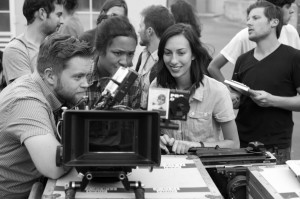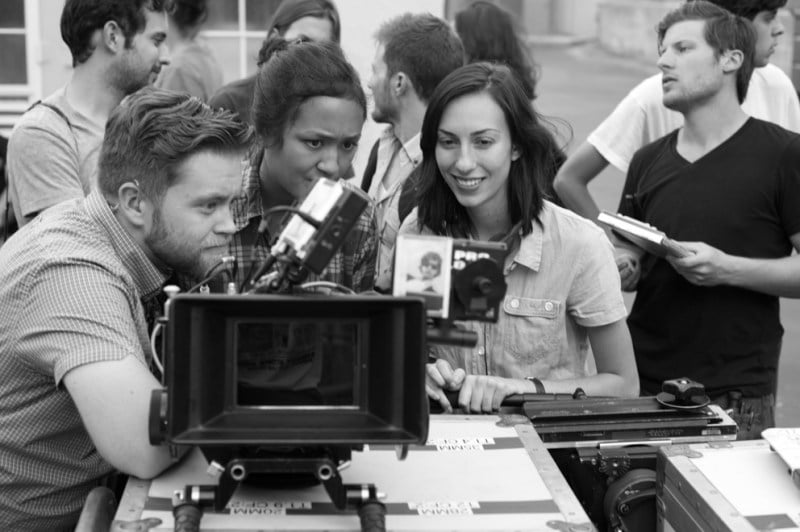
Palo Alto is a suburban community that neighbors Stanford University, the title of James Franco’s short story series about his hometown and the fictional site of Gia Coppola’s “Palo Alto,” a film based on Franco’s stories set to release on May 9.
Coppola’s film, “Palo Alto,” follows the lives of Teddy (Jack Kilmer), Fred (Nat Wolff) and April (Emma Roberts), three teenagers riding the ups and downs of suburban adolescence. Their trials and tribulations range from illicit affairs with soccer coaches (James Franco), to looking for love in the wrong places, to driving down neighborhood streets searching for nothing but something to do. The result is a dreamy yet shrewd depiction of the emotional depth that brews beneath the mundane day-to-day of suburban teenage life.
The Stanford Daily talked with Coppola about working with different artistic media, her teenage years and the making of her first feature-length film.
The Stanford Daily (TSD): What about the stories resonated with you?
Gia Coppola (GC): I felt they were really realistic about what it’s like to be a teenager, and I hadn’t seen that in a long time, and I was really excited for the opportunity.
TSD: How did you approach creating the characters on screen?
GC: I worked with the actors. We did a week of rehearsal. After a certain point, they knew the characters better than I did, so I was just really open to their suggestions and what they brought to the table.
TSD: Many of the actors were around the age of the characters in the stories and then there was Franco, who wrote the stories. What was it like working with young actors and the author who wrote the content you tried to portray?
GC: It was fun working with the young actors. They were of the age of their characters so they were naturally doing the things that needed to be shown in the film. It was just kind of right. With James, it was nice for me to have him around because I was a first-time director, and I was excited to work with him. He’s a great actor. He knows the inspiration [for] those characters, and I could really trust him to do what was right. That’s a really hard character to play, because it could easily be over the top, but he was natural, and by him being natural [it] was creepy enough just because what he’s doing is creepy.
And he’s a director, so when I got stuck at times, I could be like, “I don’t know what to do, I need help,” and he was there. He gave me a lot of freedom to have my own interpretation but was supportive at the same time.
TSD: Do you think the film adds anything different to the content that wasn’t in the book?
GC: Because they’re short stories, [the film] was more about capturing the essence. I had to combine certain characters and only use maybe four or five stories and get that tone and mood from them. That’s what adapting is. You’re working with two different media and trying to make one fit into another. You have to be willing to not necessarily be completely literal to your material. James was the perfect writer to work with because he was open to that.
TSD: The soundtrack has received significant attention. What was it like working with Dev Hynes (or “Blood Orange”), and what role does music play in the film?
GC: I’m a big fan of him, and he’s really talented. So I knew whatever he was going to do, I was going to like. He took the characters’ emotions seriously, and so whenever something seems like a big deal to them – but maybe in hindsight isn’t that big of a deal to an outsider as you get older – he still took it from the perspective of a young person and articulated the weight of what they’re doing musically. And that’s what you want when you get someone to compose your score.
TSD: The film is set in Palo Alto, but I understand the movie was mostly shot in Los Angeles?
GC: We’re low-budget so I can’t transport everyone, and the industry is mostly based in Los Angeles. I wanted to work with people I had collaborated with on my smaller projects. No one’s really getting paid and we’re all riding on enthusiasm. This book is based off of these characters and their emotions, and it just happens to take place in Palo Alto.
TSD: The book and the film seem very tied to suburbia. Do you think there’s something inherent to the experience of growing up in suburbia that lends itself to this genre of story?
GC: There’s definitely something about growing up in suburbia. There are moments where you’re at this young age when you’re too young to be with the adults and too old to be with the kids. So you end up spending most of your time looking for things to do and driving around and hanging out in parking lots. Those moments of looking for things to do are when you have your best moments.
Maybe in the city, it’s a bit different, but I think what’s universal is that everyone has these awkward growing pains. You’re physically changing, hormonally changing, and that’s universal no matter where you come from.
TSD: What were you like as a teenager? Did you go through experiences similar to those depicted in the film?
GC: Yes and no. I was really shy. I went to a private school and most of my friends were outside of my high school. I struggled academically, and so I was always kind of bummed that I just wasn’t good in that department. I wanted to be creative but I couldn’t really figure out how, so there was struggling with trying to articulate with myself and figure out who I wanted to be and what I liked. I guess that is like what April goes through.
TSD: How did you approach this project?
GC: When I met James, I sent him my photography. He wanted to make his book into a feature-length film and that was one of the ideas he proposed. I hadn’t thought about making a feature-length film, and I loved his book and was excited about the chance. I felt safe within his environment to let any pressure, or anything I was intimidated by, to drop away and just collaborate and make something. It hasn’t been until when I had to let go of the edit—they had to literally pry it out of my hands—I was like, “Oh my God, I have to show it to the world, I’m not ready for that!” But I couldn’t touch it anymore. I was only hurting it by fiddling with it.
James made it a step-by-step process and made me feel safe so I could be free with it and not worry about any judgment later on.
TSD: One of the things I found interesting about the film was that there wasn’t too much dialogue. Was that intentional? How did you balance the dialogue with the visuals?
GC: There was great dialogue in James’s book, and we used it at those moments. But I love moments when they’re just purely observational, and you can gain so much just from visually looking at something. The characters’ bedrooms say a lot about characters. Articulating without words is sometimes enough.
TSD: Yeah. Even in the intimate scene between James’ and Emma’s characters, there was a close-up of her necklace. What was it like brainstorming those details?
GC: I enjoy being involved in all that little stuff. That was a Jen Meyer necklace—I wanted her to have her signature necklace piece and that was a sweet, teenage girl necklace. I felt like I wanted to show a sex scene in a way that wasn’t a straightforward way, like, “Here we go, there’s a sex scene,” which, at least for me, it’s just not very entertaining anymore. It’s just always very standard.
I wanted to show it in a way that was different and convey it in a way where you can feel more the dynamics of what’s going on rather than seeing it and be abstract. That was fun for me to kind of play with that.
TSD: That scene really stood out to me because it was all about Emma’s character—the scene focused on just one actor, and I really loved that.
GC: Oh, cool. Sometimes I’m just like, “Maybe I should’ve put his hand in there.” It was sort of a random thing, like, “Wouldn’t it be nice to do it that way?” Everything comes together naturally in the film, during the editing process. You figure out the direction of where it needs to go.
TSD: What do you hope audiences will walk away with from the film?
GC: My job is to make something that people can connect to and feel less alone sometimes and relate. That’s why you enjoy reading books because they can resonate with you in some form or another. I hope that I can do that for people.
Contact Madeleine Han at mhan95 “at” stanford.edu.
